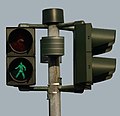Traffic lights, which may also be known as
stoplights,
traffic lamps,
traffic signals,
stop-and-go lights,
robots or
semaphore, are signaling devices positioned at road intersections, pedestrian crossings and other locations to control competing flows of traffic. Traffic lights have been installed in most cities around the world. They assign the right of way to road users by the use of lights in standard colors
(Red - Amber - Green), using a universal color code (and a precise sequence, for those who are color blind).
Types of traffic lights
Three-set lights

Typical set of traffic lights in Spain
The universal standard is for the red to be above the green, and if there is also an amber it is placed in the middle.
[citation needed] If the three-set lights are mounted horizontally, the red will typically be to the left of the green. The standards apply whether the country drives on the left or the right, but the placement of the mountings on the road would be mirror images of the other.
Go-stop sequence
In most countries, the sequence is green (go), amber (prepare to stop), and red (stop). In Russia, Serbia, Bosnia and Herzegovina, Austria, Israel, and parts of Canada and Mexico, the green light flashes for a few seconds before the amber light comes on. In New Zealand
and Canada, amber officially means 'stop (unless it would cause an accident to do so)' but in practice,
[citation needed] is treated as 'prepare to stop'.
Stop-go sequence
In most
[citation needed] countries the sequence is red (stop), green (go). In some countries, the sequence is red (stop), yellow (prepare to go), green (go). In some places, such as the UK, Germany and Russia, the sequence is red (stop), red and amber (stop, prepare to go), green (go if clear).
Flashing yellow light
In some countries, a flashing yellow light means that intersection must be treated as non-signalized, other road signs such as "yield" or "major road" must be obeyed if present. The single flashing amber signal is used in the UK, Ireland and Australia at Pelican crossings. It is used in Serbia and the United States to mark places where greater attention is needed (dangerous crossings, sharp curves etc.).
[citation needed] In Canada, a flashing amber light means "drive with caution" and is frequently combined with a flashing red light (meaning "stop") at four-way intersections. In many South East Asian countries (e.g. Thailand) and European countries, a flashing amber light indicates a driver may proceed cautiously across a junction where signals operate only at busy periods.
Flashing red light
A flashing red is usually treated as a stop sign.
Pedestrian crossing lights
Typical pedestrian crossing light
| Pedestrian crossing light with loudspeaker for the blind
| A crosswalk traffic signal in Poá, Brazil
| Three-state pedestrian lights
|
Traffic light with counter (seconds until green light) in Kiev
 Overview of UK 4-state traffic lights:
1. Stop
2. Stop
3. Go if clear
4. Stop if safe to do so
|








0 comments: on "Traffic light"
Post a Comment